Reserve Bank of Australia Annual Report – 1985 Financial Markets[*]
Financing
After two years of strong growth, the public sector reduced its demands on the capital market in 1984/85, largely as a result of the reduction in the Commonwealth Government's deficit. This reduction, however, was more than offset by the increase in corporate sector demand, associated largely with the recovery in investment spending. With growth in household savings meeting only part of the additional demand for finance, there was increased recourse to overseas sources of funds. Net flows of finance between sectors are shown in Graph 5.
The Commonwealth deficit in 1984/85 was $6,752 million, or about 3.3 per cent of GDP. This was more than $1 billion less than the deficit of $7,961 million in 1983/84, and very close to the estimate of $6,745 million in the Budget. As in 1983/84, domestic funds were raised largely by primary issues of bonds at tender. Interest rates on ASBs, which are intended to tap household savings, lagged well behind market rates for much of the year, with the result that redemptions exceeded new subscriptions.
In 1984/85 the Commonwealth's gross borrowing abroad was $1,809 million ($907 million net of repayments) compared with $1,174 million in 1983/84 ($358 million net of repayments).
New raisings by local and semi-government authorities in 1984/85 were estimated at $8.4 billion, about $0.9 billion above the level raised in 1983/84. Of the total, approximately $2.5 billion was raised abroad.
| Announced |
Currency |
Net Proceeds ($Am) |
|---|---|---|
| 26 July 1984 | Yen | 490 |
| 1 August | Yen | 244 |
| 1 October | Guilders | 139 |
| 30 October | Deutschemarks | 236 |
| 22 February 1985 | Swiss francs | 260 |
| 14 May | US dollars | 440 |
The net borrowing requirement of the public sector in 1984/85 was around $13 billion. This was equivalent to about 6 per cent of GDP, 1 percentage point lower than in the preceding year.
5 SECTORAL BALANCES

Borrowing and lending by all financial institutions rose by around 16 and 18 per cent, respectively, in the year to June 1985, compared with annual growth rates of around 11 and 13 per cent, respectively, in the year to June 1984. As summarised in the table below, financing by banks grew more rapidly than financing by non-bank financial intermediaries. In the year to June 1985, M3 grew by 17.5 per cent, well above its growth of 10.8 per cent in the year to June 1984. Growth of broad money (on the same basis) increased to 15.8 per cent in 1984/85, from 11.4 per cent in 1983/84.
6 GOVERNMENT FINANCE

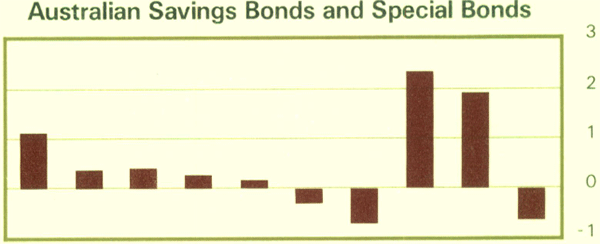
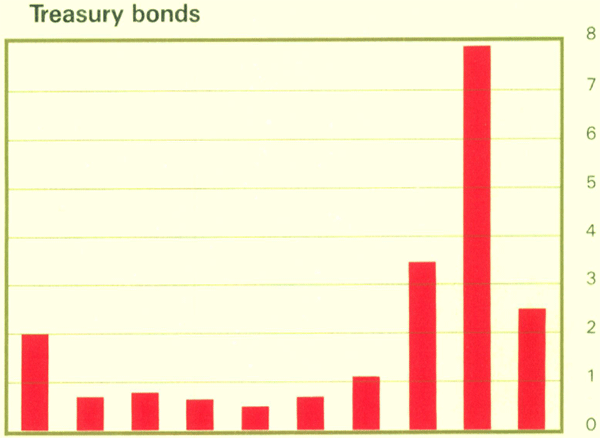
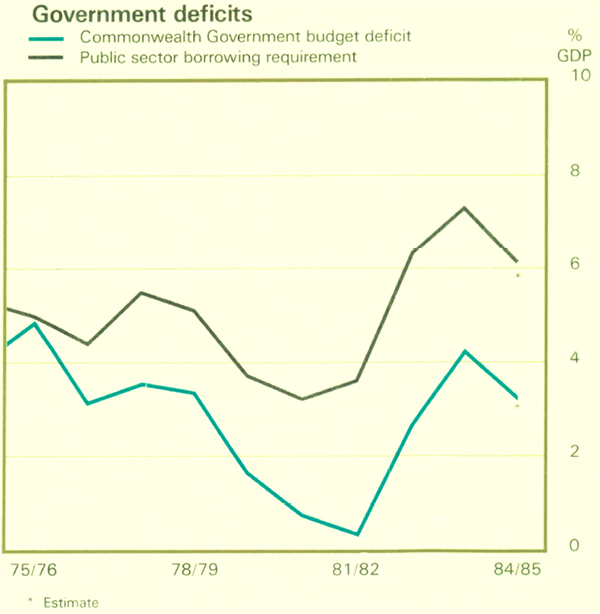
The divergence between measured growth rates of banks and non-bank financial intermediaries in 1984/85 was exaggerated because two non-banks became banks during the year. Commencement of savings bank business by Advance Bank Australia (previously the N.S.W. Building Society) reduced growth of non-bank borrowings by around 1¾ percentage points in 1984/85 and increased the growth of bank deposits by around 1¼ percentage points. Commencement of trading bank business by Macquarie Bank (formerly Hill Samuel Australia) reduced growth of non-bank borrowings and increased growth of bank deposits by around ½ and ¼ of a percentage point respectively.
Newly-available data suggest that growth of non-bank financial intermediaries may have been overstated by about 2½ percentage points as a result of double-counting; i.e. by transactions among financial institutions. There was also a marked shift in the pattern of financial business passing through intermediaries. Growth in lending to the private sector by intermediaries was particularly strong. This was partly offset by a decline in the rate of growth of their lending to governments.
With financial intermediaries adding relatively little to their holdings of government paper there was a strong rise, estimated at around $11 billion, in holdings of Commonwealth Government and semi-government securities by the non-finance sector; this followed an increase of about $10 billion in the preceding year. Bank accepted/endorsed commercial bills held by the non-finance sector also increased by around $4 billion in 1984/85. Other areas of direct finance were less buoyant. Issues of corporate debentures were subdued and there was a reduction in direct overseas raisings by Australian companies. New equity raisings on the Australian capital market continued at around the same pace as in 1983/84, despite a strong recovery in the Australian sharemarket during the year; from June 1984 to June 1985, the ‘all ordinaries’ index rose from 662 to 855, an increase of nearly 30 per cent.
| 1981 | 1982 | 1983 | 1984 | 1985 | |
|---|---|---|---|---|---|
| Deposits with banks of which: | 12.7 | 11.2 | 12.9 | 10.4 | 17.8 |
| Savings banks (a) | 9.3 | 7.7 | 19.2 | 15.2 | 10.2 |
| Borrowings by non-bank financial institutions (a) (b) | 18.7 | 17.8 | 11.1 | 11.5 | 13.3(d) |
| Borrowings by all financial institutions (c) | 15.8 | 13.9 | 11.5 | 11.2 | 15.9(d) |
| Total lending by all financial institutions (c) of which: | 16.6 | 13.1 | 11.3 | 13.1 | 18.2(d) |
| Lending to private sector | 17.4 | 15.9 | 10.9 | 12.1 | 20.6(d) |
| Lending to government | 13.1 | 1.3 | 13.1 | 18.0 | 7.0(d) |
| (a) Figures for the year to June 1985 are influenced by the commencement of banking business by Advance Bank (previously the N.S.W. Building Society) and Macquarie Bank (previously Hill Samuel Australia) (b) Corporations reporting monthly under the Financial Corporations Act, plus cash management trusts (c) Banks plus corporations under (b) (d) Preliminary |
|||||
7 INDICATORS OF FINANCIAL CONDITIONS
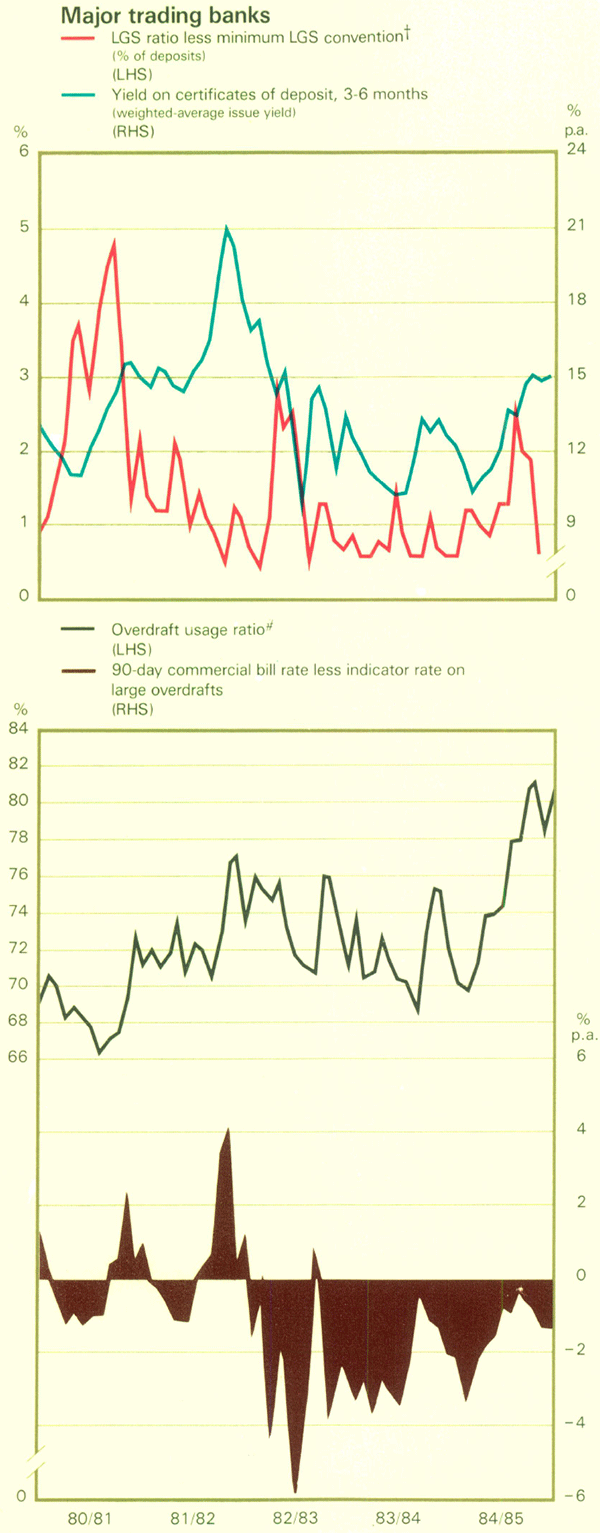
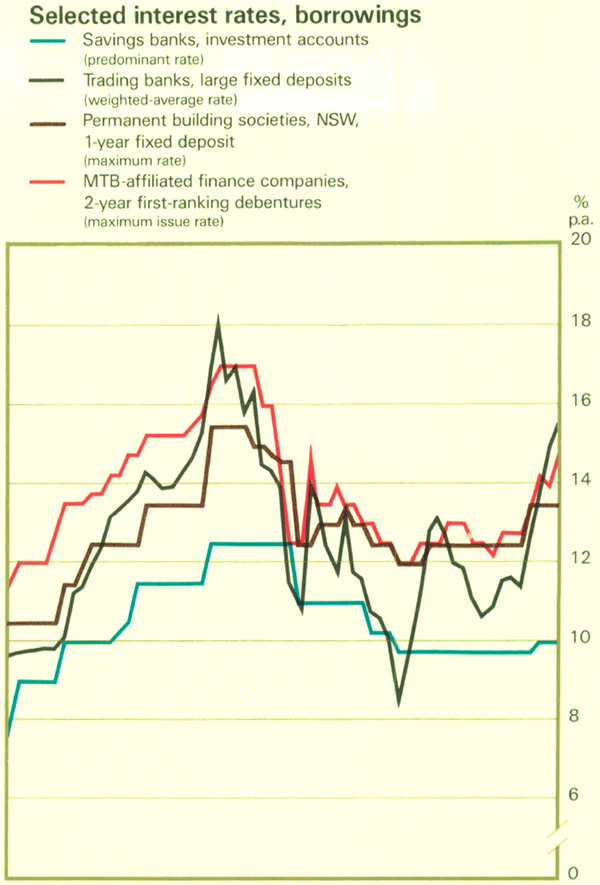
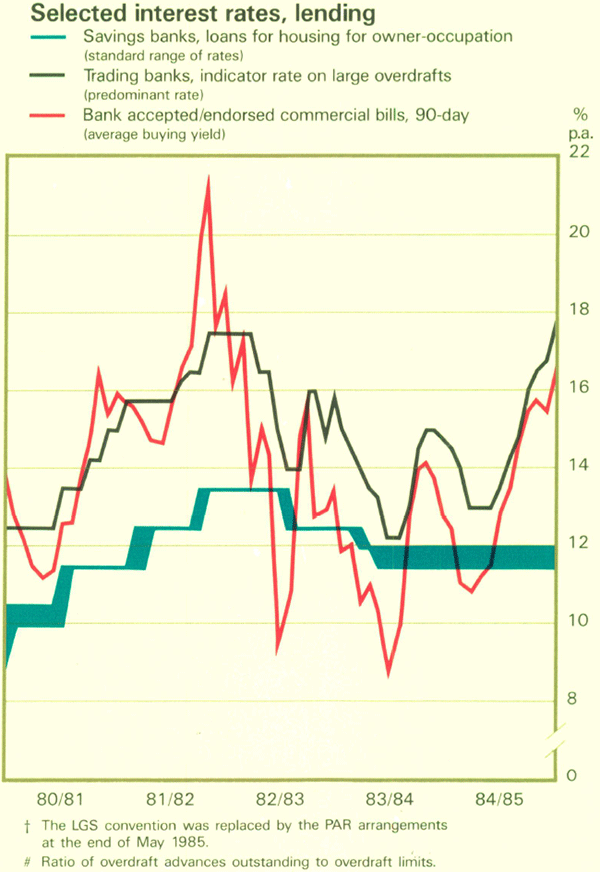
8 FINANCIAL INSTITUTIONS: BORROWINGS AND ADVANCES OUTSTANDING
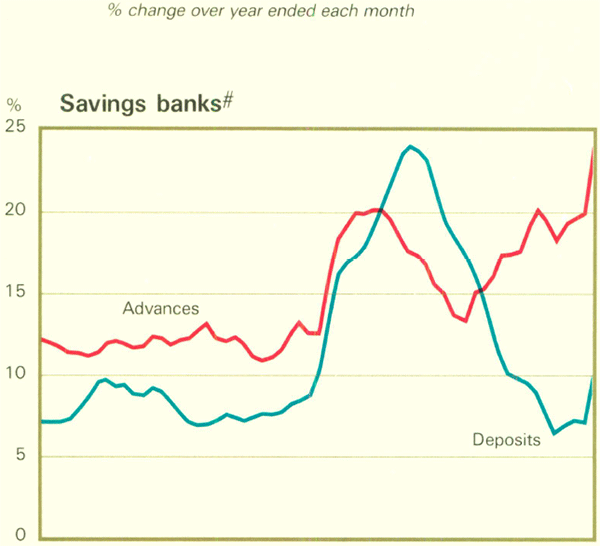
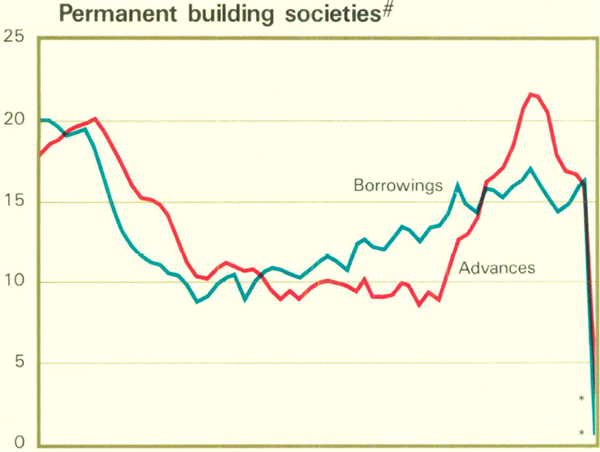
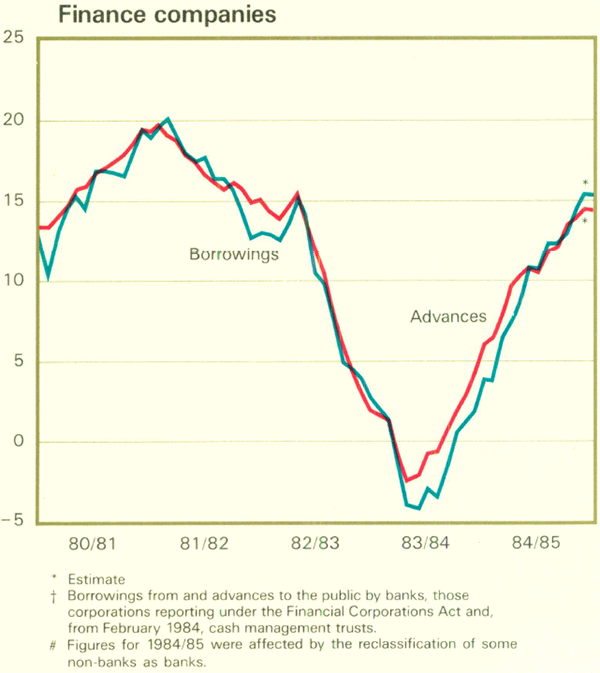
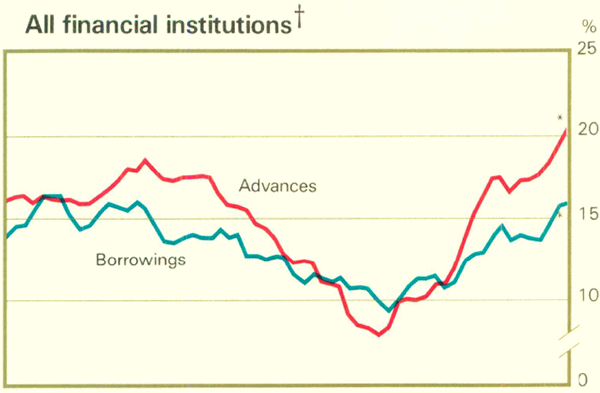
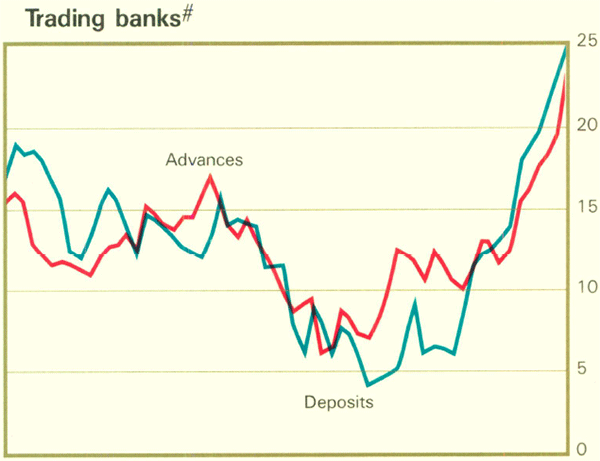
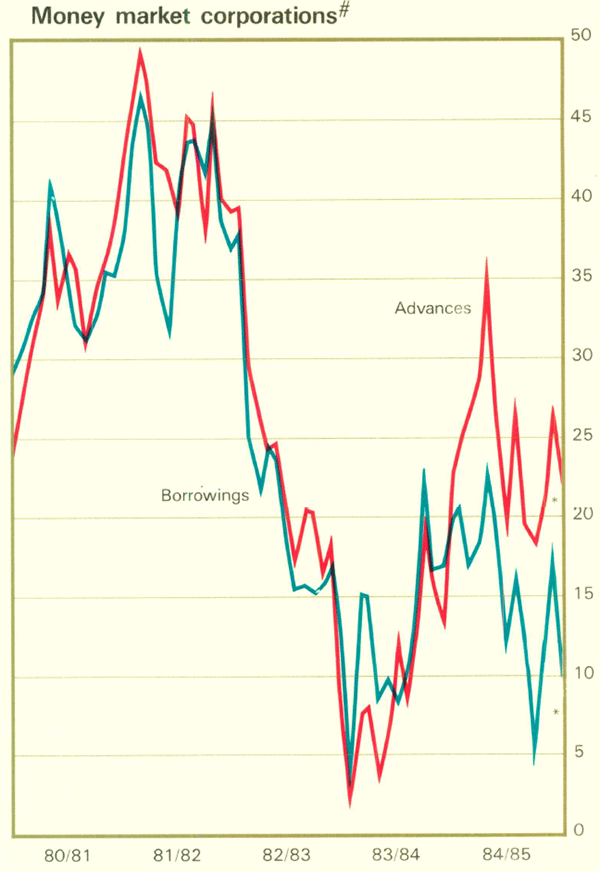
The extra demands for finance generally, and from financial intermediaries in particular., contributed to a rise in interest rates over the course of the year.
Financial Institutions
Deregulatory measures had a significant influence on the performance of different groups of financial intermediaries in 1984/85.
A major effect of deregulation has been to increase competition among intermediaries. More specifically, deregulation has increased the scope for banks to compete with other financial institutions. The removal of interest rate controls on bank deposits in August 1984, and on small business and personal loans in April 1985, were important in this respect. State governments have proposed, and in most cases enacted, legislative amendments that will reduce restrictions on building societies. In N.S.W., amendments reducing restrictions on credit unions have been enacted and similar proposals are being considered in some other States.
Competition among financial intermediaries in 1984/85 was also influenced by the Government's announcement of its intention to issue additional banking authorities and to set aside, temporarily, foreign investment policy requirements in respect of merchant banks. These announcements stimulated competition for market share among those intermediaries with banking aspirations, merchant banks wishing to establish favourable balance sheet positions prior to ownership restructuring, and existing banks wishing to increase their market shares prior to the entry of new banks. As sketched in the preceding section, the net outcome of these influences was a strong increase in financing by intermediaries and, within that total, a shift from non-bank financing to bank financing. Developments within the year were uneven. Differences in the patterns of financing by various groups of intermediaries become clearer if the year is considered as three separate four-month periods.
Growth in borrowing and lending by all financial institutions accelerated in the first four months of the financial year. Competition between groups of intermediaries was especially vigorous; there were signs that lending was being conducted on very fine margins over cost. While banks were generally low-key in bidding for short-term deposits, the capacity to attract deposits if necessary from a wider base enabled them to be more aggressive in their lending activities. Lending by money market corporations grew particularly quickly in this period. All categories of their lending increased, especially short-term placements of funds and holdings of commercial bills. Some corporations sought to restructure their activities in an effort to establish a lasting niche in a rapidly changing market. It also appears that the strong growth of intermediaries between July and October was influenced by expectations of interest rate falls as well as by the demand for credit and strong competition for business.
| All Financial Institutions | All Banks(a) |
Money Market Corporations(a) | Building Societies(a) | Finance Companies | Other Financial Institutions(b) |
|||||||
|---|---|---|---|---|---|---|---|---|---|---|---|---|
| Borrowing | Lending | Borrowing | Lending | Borrowing | Lending | Borrowing | Lending | Borrowing | Lending | Borrowing | Lending | |
| July to Oct | 6.4 | 7.7 | 4.5 | 6.5 | 9.3 | 17.2 | 6.7 | 6.4 | 7.4 | 5.6 | 13.8 | 6.8 |
| Nov to Feb | 4.9 | 3.9 | 7.2 | 5.6 | −1.7 | 0.6 | 6.0 | 6.0 | 1.1 | 0.9 | 0.5 | 2.5 |
| Mar to June(c) | 3.9 | 7.7 | 5.1 | 9.9 | 8.9 | 11.1 | −2.9 | −1.8 | 5.3 | 6.2 | −2.5 | 9.7 |
|
(a) Figures for March to June are influenced by the commencement of banking business by Advance Bank (previously the N.S.W. Building Society) and Macquarie Bank (previously Hill Samuel Australia) (b) Credit unions, authorised short term money market dealers, pastoral finance companies, general finance companies and cash management trusts (c) Preliminary |
||||||||||||
In the four months to October, lending in Australia by banks and money market corporations grew considerably faster than their borrowings in Australia. Their net borrowing from abroad made up most of the balance. In part this reflected an increase in the proportion of overseas borrowings by corporations passing through the books of intermediaries. It also reflected the tendency for intermediaries to use foreign currency borrowings to finance domestic currency lending, with the exchange risk hedged through the forward exchange market, either by the intermediaries or by their clients.
From around late October there was a sharp slow-down in activity by non-bank financial intermediaries. While most non-banks experienced some slowing, it was most pronounced for money market corporations (see table on page 21). An important element from late October to early April was a marked shift of financing to banks from other financial institutions. With bill yields rising more sharply than overdraft rates, there was an incentive throughout most of this period for borrowers to seek overdraft finance from banks. The shift to bank finance impacted strongly on money market corporations and, to a lesser extent, on finance companies. The impact on other financial intermediaries was slower to take effect. Building societies, in particular, maintained their strong growth throughout the second half of 1984 and into 1985 as a result of strong demand for housing finance.
From around March, activity of non-bank financial intermediaries again grew strongly. Banks also maintained their high rates of growth, with the result that total financing by intermediaries increased substantially. Lending grew particularly strongly in this period, with all groups of intermediaries adding to the expansion. This period also saw further borrowing from abroad by banks to fund lending in Australia. Borrowing by companies to meet tax payments boosted bank lending. Expectations that interest rates would fall after the seasonal tax collection period was an important factor in the build-up of commercial bills on the balance sheets of money market corporations in May. Leasing deals were prominent in finance companies' new lending and housing loans by building societies reached their highest monthly rate for the year, although other forms of lending by building societies declined.
The need to fund rapid growth in lending in this period put considerable pressure on the market for short-term deposits. Banks were particularly heavy bidders for funds in the call money market to fund the growth in their overdrafts, to replenish liquidity and to roll over their substantial portfolios of short-term borrowings. For a period, pressures in the short-term money market were exacerbated by heavy use of overdrafts to fund tax payments and other commitments and, in some cases, to place the funds in the call money market at a profit.
Deregulation and Institutional Developments[*]
There have been many changes in financial markets in recent years. Some have reflected explicit initiatives of deregulation. Some have refleted necessary changes to institutional arrangements in particular areas of the market in response to deregulatory initiatives in other areas. Other developments have reflected natural adaptation by institutions themselves to the changing economic and regulatory environment. This section summarises the main developments in 1984/85.
New banking authorities
During the year, the Government announced the prospective entry into Australia of 16 new banks with varying degrees of foreign ownership. Discussions are proceeding between the 16 applicants, the Reserve Bank and the Treasury with a view to developing proposals to the point where recommendations can be made to the Governor-General for the granting of authorities to carry on banking business. A number of proposals are well advanced.
Of the 16 proposed new banks announced by the Government (see inset), six are from the Asia/Pacific region, six from North America and four from Europe. Eight of the proposals involve Australian equity participation, ranging from 20 to 50 per cent. Seven propose to locate their headquarters in Sydney, five in Melbourne, one in each of Adelaide and Perth, and two propose to split their head offices between Sydney and Melbourne.
In addition to this process, three new authorities to carry on banking business were issued during the year. In September, the Government announced that it had initiated proceedings to enable the Bank of China to open a branch in Australia. This decision recognised the special historical circumstances involved; the Bank of China was initially issued a banking authority in 1942, but subsequently ceased to conduct business in Australia. Authority was granted to the Bank of China in April to carry on banking business in Australia as a trading bank. The Australian branch will be permitted to offer a full range of banking facilities although it will be placing emphasis on the facilitation of trade and investment between Australia and the People's Republic of China.
Selected applicants for new banking authorities
- Bank of America National Trust and Savings Association/GJ. Coles and Coy Ltd.
- The Chase Manhattan Bank, N.A./Australian Mutual Provident Society.
- Citibank, N.A.
- J.P. Morgan & Co. Inc.
- Bankers Trust Corporation.
- The Royal Bank of Canada/The National Mutual Life Association of Australasia Limited.
- Barclays Bank PLC.
- National Westminster Bank PLC.
- Standard Chartered Bank PLC/State Government Insurance Commission (of SA)/Advertiser Newspapers Limited.
- The National Bank of New Zealand Limited.
- The Bank of Tokyo Ltd.
- The Industrial Bank of Japan, Limited/Western Australian Development Corporation/Town & Country WA Building Society/ State Government Insurance Office (of WA).
- The Mitsubishi Bank, Limited/The City Mutual Life Assurance Society Limited/Howard Smith Limited.
- Deutsche Bank AG.
- The Hong Kong and Shanghai Banking Corporation/Victorian Economic Development Corporation.
- Oversea-Chinese Banking Corporation Limited.
In February, the Macquarie Bank Limited (previously Hill Samuel Australia Ltd) was granted an authority to carry on banking business in Australia as a trading bank. It commenced operations on 1 March. On 1 June, an authority was granted to the Advance Bank Australia Limited (previously the N.S.W. Building Society) to carry on banking business as a savings bank. It commenced operations on that day.
Ownership requirements
At the time it called for applications from interests wishing to set up banking operations in Australia, the Government also announced that it was setting aside, for twelve months, the existing foreign investment policy requirements in respect of merchant banks (money market corporations). This was to facilitate the rationalisation of ownership of merchant banks against the background of the removal of bank deposit regulations in August and the prospect of new banking authorities. Taken with the Bank's earlier withdrawal of the requirement that Australian banks limit their equity interest in merchant banks to a maximum of 60 per cent, the twelve-months moratorium effectively provided the merchant banking industry with an opportunity to re-organise its then existing structure of multiple, and in some cases conflicting, shareholdings.
The market responded quickly to these changes. By the end of June 1985, the Government had approved around 30 new merchant banks. A further 18 new corporations emerged from restructuring of ownerships of existing entities. The new merchant banks are owned largely by foreign interests.
The prospective entry of new banks raised the possibility that parties with substantial shareholdings in authorised short term money market dealers might also have substantial equity interests in a bank. This would have conflicted with the Bank's guidelines on ownership of authorised dealer companies. Those companies affected were asked to inform the Bank by 30 June how any conflicts were to be resolved. In the events all parties concerned have sold or are in the process of selling their interests in authorised dealer companies to other proprietors acceptable to the Bank.
Non-bank financial institutions
During 1984/85, the Bank issued a further seventeen authorities to non-bank financial intermediaries to deal in foreign exchange.
There were several developments relating to the expansion of the secondary mortgage market in Australia. In Victoria, a market intermediary (the National Mortgage Market Corporation) was incorporated in September 1984, with minority State government equity participation; its first mortgage-backed notes were issued on 10 April 1985. The N.S.W. Government is presently developing with private sector groups a proposal for another intermediary to be based in Sydney. The Queensland Government has pursued a different course by encouraging the private sector to form the market but passing legislation which establishes a mechanism for registering approved intermediaries.
In response to representations by building societies, following the lifting of controls on banks, State governments have moved to lessen restrictions on the building society industry. Legislative amendments have been proclaimed in all States except N.S.W. and Victoria, where changes are still under consideration. While the amendments vary from State to State the general intention has been to widen both borrowing and lending powers of building societies. Changes include enabling societies to: enter into agency arrangements to provide services such as credit cards and cheque account facilities; make unsecured loans; and undertake a wider range of investments than had previously been the case.
Supervision of Banks
The on-going momentum of financial deregulation and innovation will boost the scope for, and vigour of, competition in the Australian financial system. This underscores the need for banks in particular to maintain high prudential standards. Against this background, the Bank took a number of initiatives during the year to strengthen and to codify its role in prudential supervision of banks.
As a first step, in August 1984, the Bank reorganised its supervisory functions within a separate Supervision Unit. This was intended, among other things, to prepare for the entry of new banks and to provide a focal point for discussions with banks on prudential matters.
In line with recommendations of the Campbell Committee and the Martin Group, the broad principles of prudential supervision policy in respect of banks authorised under the Banking Act have been agreed between the Treasurer and the Reserve Bank. Those principles were set out in a paper entitled ‘Prudential Supervision of Banks’ which was one of several papers published by the Bank during the year on aspects of prudential supervision. A second paper reviewed ‘Supervision of Capital Adequacy of Banks’. With assets growing strongly in 1984/85, banks increased their capital bases through retained earnings and, in some cases, new capital issues.
A third paper, ‘Supervision of the Adequacy of Liquidity of Trading Banks’, outlined the Bank's framework for supervising liquidity management by banks of their domestic operations in Australian currency. As part of this framework, trading banks have agreed to hold at all times a minimum tranche of high quality liquefiable assets (‘prime assets’). The Bank sees this tranche as important to the underpinning of confidence in banks. The Prime Assets Ratio (PAR) took effect from 30 May.
The PAR arrangements replace the LGS Convention which had operated since 1956 between the Reserve Bank and the major trading banks. In terms of the Convention, the major trading banks undertook to maintain liquid assets and Commonwealth Government securities at least equivalent to an agreed ratio to their deposits and to borrow from the Bank, if necessary, to maintain the minimum LGS ratio pending adjustment of their balance sheets. With the ending of the Convention, this arrangement no longer applies. The Bank aims to ensure that there are sufficient funds available in the market to meet the banking system's need for liquid assets without recourse to the Reserve Bank. Under the new arrangements, any assistance provided by the Reserve Bank will be at its discretion.
In assessing the adequacy of a bank's liquidity, the Bank pays attention to the maturity structure of banks' assets and liabilities; this is particularly relevant for banks which have yet to develop a broad deposit base and are dependent on the professional market to fund their assets. The Bank has warned against undue reliance on wholesale markets as a source of liquidity. The Bank will be seeking to collect regular data on the maturity structure, and other related aspects, of banks' assets and liabilities, as a basis for discussions with banks on their liquidity management.
Internationally, there has been a trend among banks to direct business ‘off balance sheet’. Instead of providing loans outright, banks offer guarantees, letters of credit or other commitments which enhance their customers' capacity to raise funds from other sources. These activities need capital to support them. While Australian banks have not moved heavily into this type of business, the Bank is seeking to improve its information in this area.
With the growing complexity of banking business, the Bank is reviewing its needs for information and, as indicated above, has taken steps to improve the timeliness and range of data required for monitoring purposes.
During the year, proposals were made by banks to have interests in life insurance underwriting. The Bank confirmed that it had no objection from the standpoint of banking supervision to banks' establishing life insurance subsidiaries, within existing guidelines on banks' associations with non-banks. In particular, banks and related life offices will be expected to conduct their respective lending and investment activities separately, and to maintain a clear arm's-length relationship.
During the year, arrangements were developed between banks and non-bank financial intermediaries to provide the latter with indirect access to the cheque payments system. Under proposed arrangements, banks will handle the clearance and settlement of cheques drawn by non-bank financial intermediaries (or their clients) with which they have agreements. The Bank's main supervisory interest in these arrangements is to see that they do not expose banks to undue risk and that confidence in the payments system generally is not impaired.
The Bank's discussions with each of the prospective new banks focused on prudential standards. Each bank has been asked to establish a corporate structure in Australia in which the new bank will be the holding company for all the group's substantial interests in Australia; to conduct any equity associations with non-banks in terms of the Bank's guidelines; to maintain during their formative years capital ratios which are somewhat higher than for established banks; to install adequate management systems; and to meet the Bank's requirements in respect of liquidity and foreign exchange operations.
Australia's Payments Systems
As mentioned in last year's Annual Report, the Bank, at the invitation of the Treasurer, provides the chairman for the Australian Payments System Council. The Council was established to monitor the development of domestic payments systems, promote the implementation of standards for electronic funds transfer systems and foster interconnection between payments systems. It is required to keep clearly in mind the principle of ensuring fair competition among financial institutions.
The Council includes representatives of the major financial industry groups involved in the development of domestic payments systems (including banks, building societies, credit unions, finance companies and merchant banks), the Commonwealth Treasury, Telecom Australia and the National Consumer Affairs Advisory Council. It is the Council's practice to consult with and, when appropriate, involve in its work others with particular interests in payments system developments. It is supported by a Secretariat drawn from the Reserve Bank.
The Council met periodically during the year and considered a range of issues. A matter of priority was arrangements by which non-bank financial institutions will gain access to the cheque payments system. The Council has also been examining electronic funds transfer systems, of which the main options are the shared common access system and the gateway system (a series of separate though interconnected systems established by individual institutions, or groups of institutions).